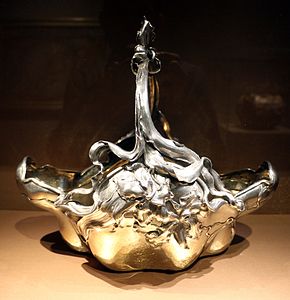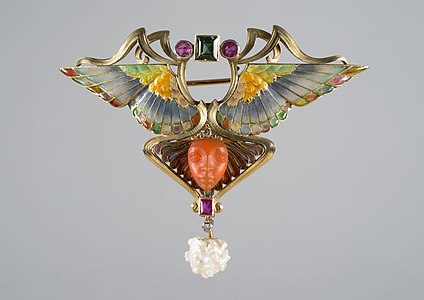Philippe Wolfers
| Philippe Wolfers | |
|---|---|
 | |
| Born | 16 April 1858 |
| Died | 13 December 1929 Brussels metropolitan area |
| Alma mater | |
| Occupation | Jewelry designer |
| Parent(s) | |

Philippe Wolfers (16 April 1858 - 13 December 1929) was a Belgian silversmith, jeweler, sculptor and designer. His mature work belongs to the art nouveau. In his later years, his work aligned with art deco. As a jewel designer he was less prolific as his french contemporary René Lalique. Nevertheless his "exemplaire unique" series of jewelry counts among the finest jewelry created in the art nouveau style.[1] Wolfers is also known for his sculptures, decorative objects and tableware executed in precious materials such as, silver, bronze, ivory and marble. He also designed vases and objects in glass and faience.
Early life and education[]
Philippe Wolfers was the son of (1820-1892) who led the family firm "Wolfers frères", silversmith and court jeweler in Brussels. The young man entered the family business as an apprentice in 1875. He further studied sculpture at the Académie Royale des Beaux-Arts in Brussels and with . With his father Philippe undertook many study trips through Europe, visiting the world exhibitions in Vienna (1873) and Paris (1889). Like many of his contemporaries he became influenced by Japanese art.
Design director at "Wolfers frères"[]
After the death of his father in 1892 Philippe Wolfers, with his brothers Max and Robert, took over the family firm and became its design director. In this role he introduced silverware in an avant-garde art nouveau style, like the fruit bowl 'Orchidées' from 1894 or one of his vases from around 1896 exhibited at the Metropolitan Museum of Art.[2]

Fruitier "Orchidées", silver, 1894

Flower pot "Orchidée", glazed earthenware, 1897
Wolfers' "exemplaires uniques"[]
Between 1898 and 1907 Wolfers produced some 130 unique pieces of jewelry. Each piece was inscribed with the words EX.UNIQUE (for "exemplaire unique") and his initials. They where intended to show the artist's craftsmanship and were submitted to important national and international exhibitions. These unique jewels were already extremely expensive at the time. Pieces that remained unsold were disassembled after some time and the precious metals and gemstones were reused to make new pieces of jewelry. This makes this type of exclusive jewelry extremely rare today. Only about 20 pieces still exist. One of his "ex. unique" brooches sold for over £23,000 at a Bonhams auction in 2012.[3] The choker "Glycines" which he created for the Paris World Fair in 1900 was sold at Christie's Geneva in 2016 for 257.000 CHF.[4]

bracelet "pavons et chauves-souris", before 1899

brooche "plumes de paon", 1898

decorative hair comb "Oiseaux et Iris", 1899

Swan pendant, 1901

brooche "Niké", 1902
Honours[]
- 1923 : commander in the Order of the Crown.[5]
References[]
- ^ "An art nouveau enamel, peridot and diamond brooch/pendant with opal drop, by Philippe Wolfers". Bonhams. Retrieved February 20, 2017.
- ^ "Vase". Metropolitan Museum of Art. Retrieved February 20, 2017.
- ^ "An art nouveau enamel, peridot and diamond brooch/pendant with opal drop, by Philippe Wolfers". Bonhams. Retrieved February 20, 2017.
- ^ https://www.christies.com/en/lot/lot-5990852
- ^ Royal order of 21 July 1923.
| Wikimedia Commons has media related to Philippe Wolfers. |
- ^ "An art nouveau enamel, peridot and diamond brooch/pendant with opal drop, by Philippe Wolfers". Bonhams. Retrieved February 20, 2017.
- 1858 births
- 1929 deaths
- Belgian silversmiths
- Belgian jewellers
- Commanders of the Order of the Crown (Belgium)
- Art Nouveau designers
- Belgian people stubs







